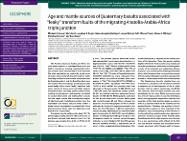Age and mantle sources of Quaternary basalts associated with “leaky” transform faults of the migrating Anatolia-Arabia-Africa triple junction

Göster/
Tarih
2021Yazar
Cosca, Michael A.Reid, Mary
Delph, Jonathan R.
Gençalioğlu Kuşcu, Gonca
Blichert-Toft, Janne
Premo, Wayne
Whitney, Donna L.
Teyssier, Christian
Rojay, Bora
Üst veri
Tüm öğe kaydını gösterKünye
Cosca, M.A., Reid, M., Delph, J.R., Gençalioğlu Kuşcu, G., Blichert-Toft, J., Premo, W., Whitney, D.L., Teyssier, C., and Rojay, B., 2021, Age and mantle sources of Quaternary basalts associated with “leaky” transform faults of the migrating Anatolia-Arabia- Africa triple junction: Geosphere, v. 17, no. 1,p. 69– 94, https://doi.org/10.1130/GES02266.1.Özet
The Anatolia (Eurasia), Arabia, and Africa tectonic plates intersect in southeast Turkey, near the Gulf of İskenderun, forming a tectonically active and unstable triple junction (the A3 triple junction). The plate boundaries are marked by broad zones of major, dominantly left-lateral transform faults including the East Anatolian fault zone (the Anatolia-Arabia boundary) and the Dead Sea fault zone (the Arabia-Africa boundary). Quaternary basalts occur locally within these “leaky” transform fault zones (similar to those observed within oceanic transform faults), providing evidence that mantle melting, basalt genesis, and eruption are linked to crustal deformation and faulting that extends into the upper mantle. We investigated samples of alkaline basalt (including basanite) from the Toprakkale and Karasu volcanic fields within a broad zone of transtension associated with these plate- boundary faults near the İskenderun and Amik Basins, respectively. Toprakkale basalts and basanites have 40Ar/39Ar plateau ages ranging from 810 ± 60 ka to 46 ± 13 ka, and Karasu volcanic field basalts have 40Ar/39Ar plateau ages ranging from 2.63 ± 0.17 Ma to 52 ± 16 ka. Two basanite samples within the Toprak-kale volcanic field have isotopic characteristics of a depleted mantle source, with 87Sr/86Sr of 0.703070 and 0.703136, 143Nd/144Nd of 0.512931 and 0.512893, 176Hf/177Hf of 0.283019 and 0.282995, 206Pb/204Pb of 19.087 and 19.155, and 208Pb/204Pb of 38.861 and 38.915. The 176Hf/177Hf ratios of Toprakkale basalts (0.282966–0.283019) are more radiogenic than Karasu basalts (0.282837–0.282965), with some overlap in 143Nd/144Nd ratios (0.512781–0.512866 vs. 0.512648–0.512806). Toprakkale 206Pb/204Pb ratios (19.025 ± 0.001) exhibit less variation than that observed for Karasu basalts (18.800–19.324), and 208Pb/204Pb values for Toprakkale basalts (38.978– 39.103) are slightly lower than values for Karasu basalts (39.100–39.219). Melting depths estimated for the basalts from both volcanic fields generally cluster between 60 and 70 km, whereas the basanites record melting depths of ˜90 km. Depth estimates for the basalts largely correspond to the base of a thin lithosphere (˜60 km) observed by seismic imaging. We interpret the combined radiogenic isotope data (Sr, Nd, Hf, Pb) from all alkaline basalts to refect partial melting at the base of the lithospheric mantle. In contrast, seismic imaging indicates a much thicker (>100 km) lithosphere beneath southern Anatolia, a substantial part of which is likely subducted African lithosphere. This thicker lithosphere is adjacent to the surface locations of the basanites. Thus, the greater melting depths inferred for the basanites may include partial melt contributions either from the lithospheric mantle of the attached and subducting African (Cyprean) slab, or from partial melting of detached blocks that foundered due to convective removal of the Anatolian lithosphere and that subsequently melted at ˜90 km depth within the asthenosphere. The Quaternary basalts studied here are restricted to a broad zone of transtension formed in response to the development of the A3 triple junction, with an earliest erupted age of 2.63 Ma. This indicates that the triple junction was well established by this time. While the current position of the A3 triple junction is near the Amik Basin, faults and topographic expressions indicate that inception of the triple junction began as early as 5 Ma in a position farther to the northeast of the erupted basalts. Therefore, the position of the A3 triple junction appears to have migrated to the southwest since the beginning of the Pliocene as the Anatolia-Africa plate boundary has adjusted to extrusion (tectonic escape) of the Anatolia plate. Establishment of the triple junction over the past 5 m.y. was synchronous with rollback of the African slab beneath Anatolia and associated trench retreat, consistent with Pliocene uplift in Cyprus and with the current positions of plate boundaries. The A3 triple junction is considered to be unstable and likely to continue migrating to the southwest for the foreseeable geologic future.

















